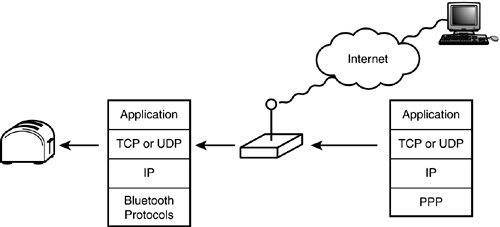Bluetooth
| The Bluetooth protocol architecture is another specification for wireless devices that is gaining popularity throughout the networking industry. Bluetooth was developed by IBM and a group of other companies. Like 802.11, the Bluetooth standard defines the OSI Data Link and Physical layers (equivalent to the TCP/IP Network Access layer). Bluetooth is actually used in place of 802.11 in some cases, and Bluetooth backers are always eager to state that some of the security problems related to 802.11 do not apply to Bluetooth. However, IBM's official line is that Bluetooth and 802.11 are "complementary technologies." Whereas 802.11 is designed to provide an equivalent to Ethernet for wireless networks, Bluetooth focuses on providing a very reliable and high-performing environment for wireless devices operating in a very short range (10 meters). Bluetooth is designed to facilitate communication among a group of interacting wireless devices in a small work area defined within the Bluetooth specification as a Personal Area Network (PAN). Bluetooth devices are not necessarily computers (although they could be). A Bluetooth network might consist of a wireless headset and a mobile phone, or a mobile phone with a handheld PDA. Bluetooth could also be used for a wireless connection from a personal home computer to a printer. Like other wireless forms, Bluetooth uses an access point to connect the wireless network to a conventional network. (The access point is known as a Network Access Point, or NAP in Bluetooth terminology.) The Bluetooth Encapsulation Protocol encapsulates TCP/IP packets for distribution for delivery over the Bluetooth network. The Bluetooth standard does not specify which protocols must operate above the low-level Bluetooth protocols. Vendors are free to implement Bluetooth in a variety of ways. However, when it comes to connections between Bluetooth devices and computers, there is no reason to believe the popular TCP/IP protocol will be any less popular in a Bluetooth environment. Figure 22.8. A computer can communicate with the Bluetooth infrastructure using PPP through a cell phone connection.
Of course, if a Bluetooth device is to be accessible through the Internet, it must be accessible through TCP/IP. Vendors envision a class of Internet-ready Bluetooth devices accessible through a Bluetooth-enabled Internet bridge (see Figure 23.8). A Bluetooth Network Access Point device acts as a network bridge, receiving incoming TCP/IP transmissions and replacing the incoming Network Access layer with the Bluetooth network access protocols for delivery to a waiting device. Figure 22.9. A Bluetooth-enabled Internet bridge.
By the Way Authors and linguists are delighted that the creators of this technology did not use an acronym for it. But why did they choose the name Bluetooth? IBM, of course, always marks its territory with blue, but why the tooth? Because it crunches data? Because it takes bytes? Forget about finding a metaphor. Bluetooth is named for the Viking king Harald Bluetooth, who ruled Denmark and Norway in the eleventh century. King Harald is famous for converting to Christianity after watching a German priest succeed with a miraculous dare. Bluetooth was loved by many, but his rule was often arbitrary. He seems to be the model for the bad guy in the William Tell legend, having once commanded that one of his subjects shoot an apple off his son's head. The marksman made the shot, but then announced that, if he'd missed, he had three more arrows to shoot into Bluetooth's heart. As we enter the wireless Valhalla, we'll hope the devices ruled by the new Bluetooth do not exhibit this same propensity for spontaneous vengeance. |
EAN: 2147483647
Pages: 259

